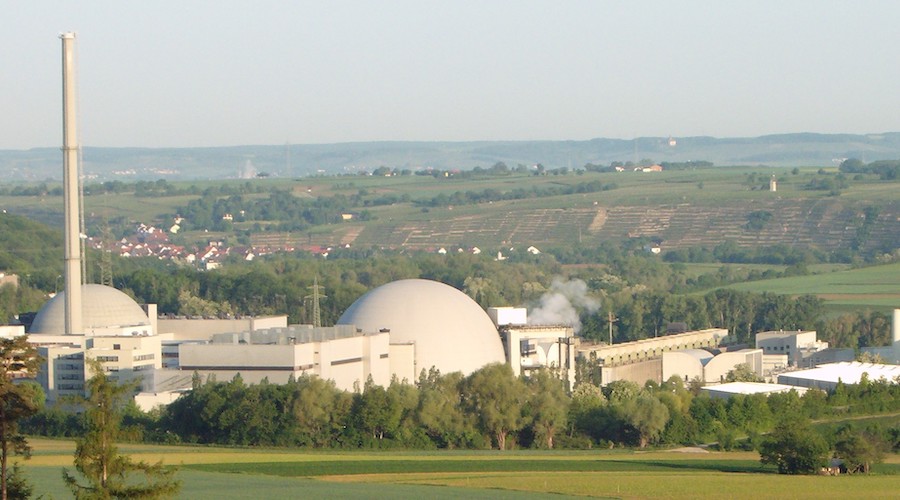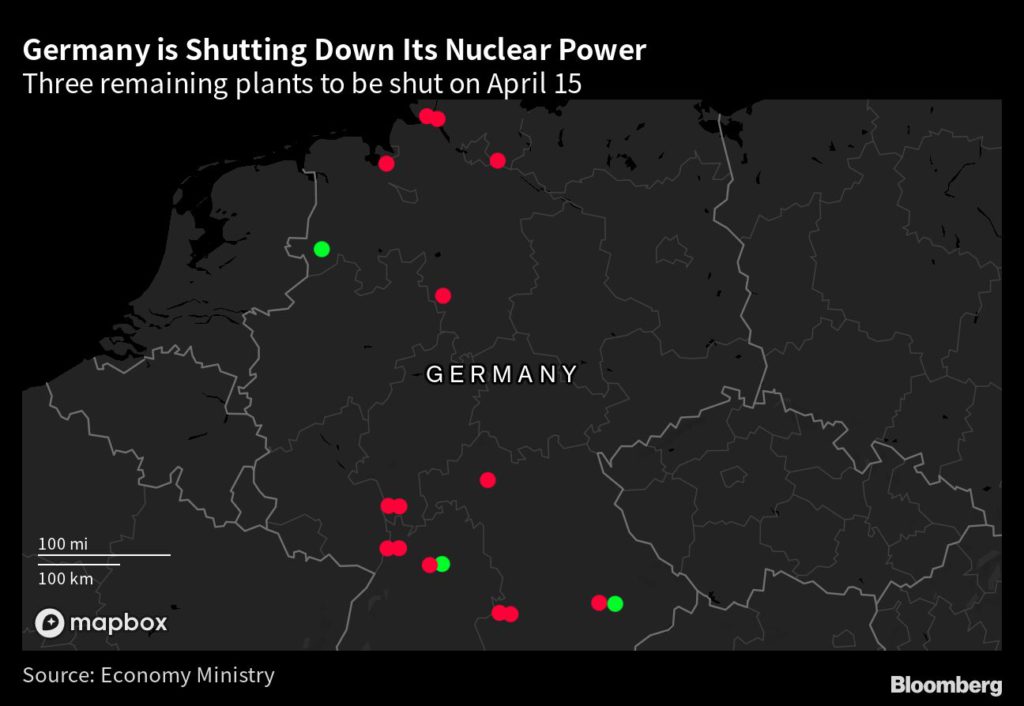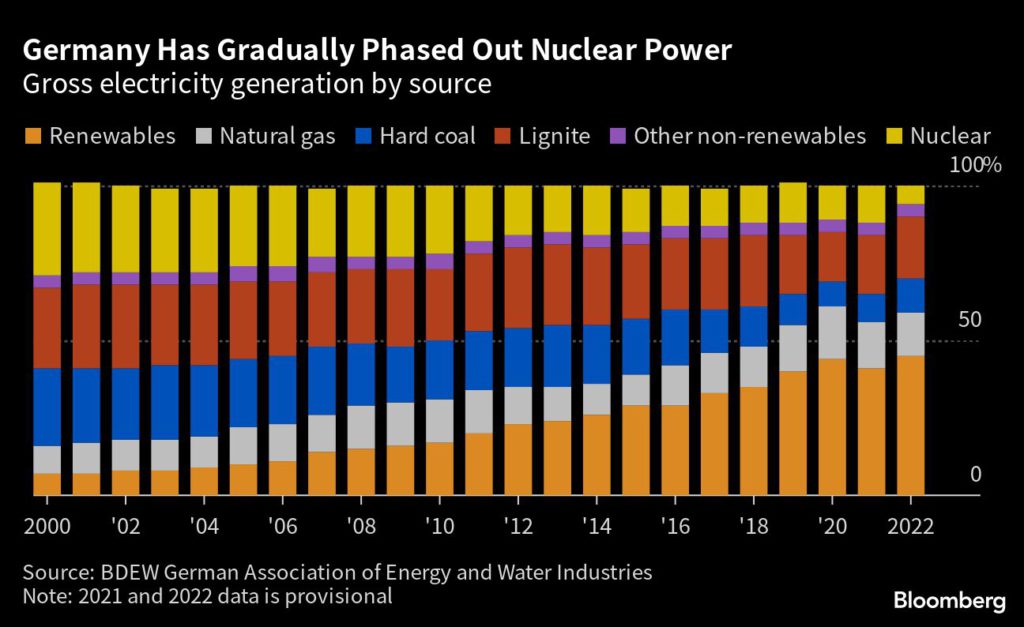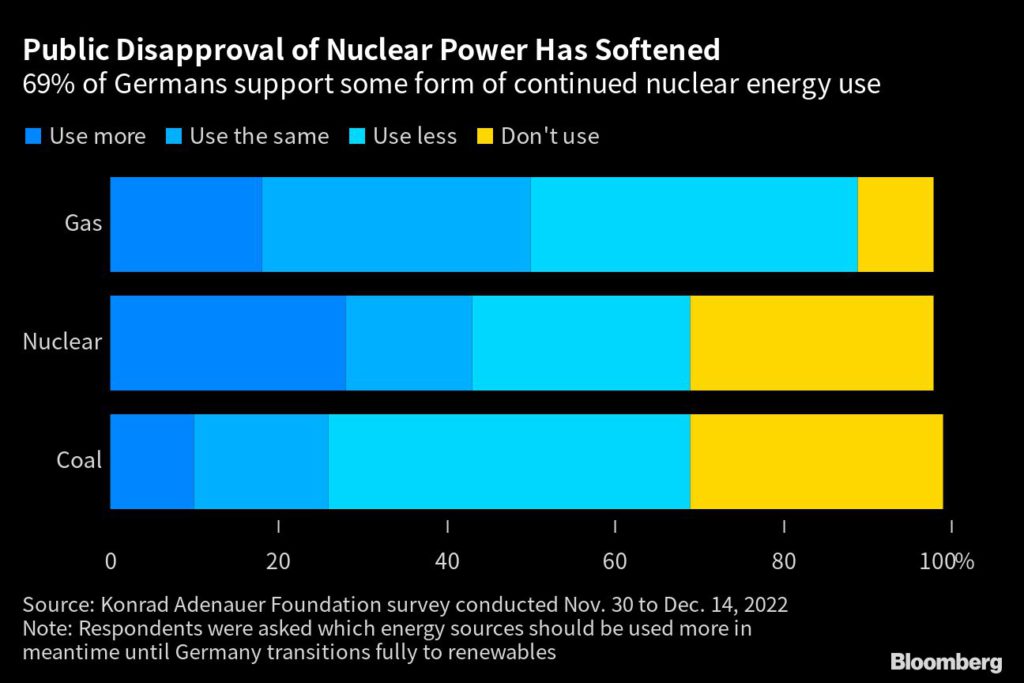
At 10 p.m. on Saturday, the Isar-2 nuclear plant near Munich will begin winding down its power generation in steps of 10 megawatts per minute.
After about 45 minutes, it will drop to 30% capacity and automatically sever from the national electricity grid. The other two plants still in operation, Neckarwestheim-2 and Emsland, will by then be in the midst of a similar process. By midnight, all three will be offline, ending Germany’s tumultuous six-decade reliance on nuclear energy.
When the three plants, which collectively provided Germany with 6% of its power last year, finally shut off, Europe’s largest economy will face an unprecedented challenge: securing its energy supply without nuclear or Russian natural gas, and with renewables expanding at a slower pace than needed.
The decision to phase out the emissions-free power source — first codified in a 2002 law and finalized after the 2011 Fukushima disaster — also comes at a moment in which many countries are moving in the opposite direction.
While Germans have historically been deeply opposed to nuclear energy, that has shifted in recent years as it has come to be viewed as something like the least bad option in the transition to a green economy. Critics worry that until Germany has sufficient clean-energy infrastructure in place, which could still be years away, the country will draw even more heavily on polluting fuels like coal to compensate for the loss.
Swedish environmental activist Greta Thunberg has criticized the move away from nuclear, and in a survey conducted late last year, some 69% of the German public say they would support some form of continued nuclear power use until renewables were able to replace it.

For a brief moment last year, as Russia’s invasion of Ukraine prompted Chancellor Olaf Scholz to shatter many major taboos of post-World War II German politics, the idea that the country could double down on its commitment to nuclear energy did not seem so far flung.
In a groundbreaking speech delivered three days after the war began, Scholz announced his intent to massively increase military spending and break ties with Russia. With Europe’s peace and stability at stake, even the country’s deep-rooted aversion to nuclear energy seemed up for debate.
But nothing came of that, and after scrambling late last year to secure a roughly 100-day extension for sunsetting the nuclear plants, policymakers have shown no intention of reversing their decision.
The reasons are political and logistical. After nearly two decades on the sidelines, Germany’s Green party, which sees nuclear opposition as the crux of its political identity, joined the federal government in 2021 as a member of the ruling coalition. It was reluctant to agree to last year’s extension, and has pushed hard to shut down the plants, claiming that the dangers they pose far outweigh the advantages.
Moving away from the “high-risk form of energy” won’t threaten Germany’s energy supply, Environmental Minister Steffi Lemke from the Green party said in an interview, adding that eliminating the risk of “devastating environmental disasters” will ultimately make the country safer.
When the three plants shut down, it will represent the culmination of a decades-long process to wean Germany off nuclear energy. At its peak in 2000, atomic power represented almost 30% of all electricity generated in Germany. Shortly before their closure, that dropped to less than 4% — an amount that Mario Ragwitz, director of the Fraunhofer Research Institution for Energy Infrastructures and Geothermal Systems, anticipates “is roughly equivalent to what will be added next year in terms of solar and wind power.”

Yet that’s not certain to meet Germany’s power needs. To sidestep a possible electricity shortfall, Germany may need to import more nuclear power from neighboring France. For the coming winter, however, Germany’s grid operators don’t expect France to have enough output for exports as the country has been grappling for more than a year with extensive reactor repairs and outages.
That may force Berlin to also seek power from other neighbors — or to repeat last winter’s strategy of burning more coal.
Compared to last year, said Ragwitz, the country now has “higher levels of gas storage, more natural gas import capacity, and additional coal-fired power plants on the market.”
Indeed, Germany was able to construct several new liquefied gas terminals within a year of Russia’s invasion. But when it comes to building new solar and wind farms, companies complain that there is still too much red tape.
The apparent trade-off of clean sources for energy security is one indication of how Germany is struggling on multiple fronts to secure its emissions-free future. In addition to phasing out nuclear, the Scholz government is also aiming to shut down coal plants by the end of the decade — 8 years ahead of schedule — to cut carbon emissions, and has called for the construction of new gas-power plants that can eventually be converted to hydrogen.

Germany isn’t the only country committed to walking away from nuclear — Italy gave up the technology in 1990, and Lithuania recently struck a deal to dismantle its Soviet-era reactors, which have sat idle for over a decade. But in many advanced economies, nuclear is experiencing a resurgence.
On Sunday, Finland will start regular power production at Europe’s newest and biggest reactor. The 1,600-megawatt Olkiluoto-3 unit that faced years of delays had been planned to enter commercial production on Monday. France is planning to build at least six new reactors by 2050 as well as experiment with smaller, modular ones. Poland, the Czech Republic and the Netherlands are among other European nations that are also planning to build atomic plants to refuced their reliance on fossil fuels. The UK has similar ambitions. And even in Japan, after a decade of paralysis following nuclear accident in Fukushima, the public is warming up to the use of nuclear power. The Japanese government wants to restart reactors that have sat idle since the disaster, and to extend the lifespan of existing units.
But one reason why many nuclear plants are still running may simply be because it’s hard to shut them down. When Germans wake up on Sunday in a country without nuclear energy, they will be faced with another question — what to do with the plants themselves. Dismantling nuclear infrastructure — and finding appropriate locations to store radioactive waste — is a complicated process that can take decades to implement, and so far, there aren’t many successful examples.
One exception is Kahl, Germany’s first nuclear power plant, which was built on an industrial site where lignite had been mined half a century earlier. The Bavaria-based plant was completely dismantled in 2010 after 25 years in operation, yet the site is once again in the business of energy generation: it now hosts companies that produce e-car batteries and components for charging stations, and run solar panels on their roof.
(By Carolynn Look, Petra Sorge and Josefine Fokuhl, with assistance from Jan-Patrick Barnert)
4 Comments
Mark
May I ask what “greener pastures” are they seeking? I think the west has lost it’s mind.
Phil Chubb
A huge mistake for a supposedly advanced industrial nation. Do Germans really think they’ll be safer from nuclear disasters by shutting down their own plants when they’re surrounded by countries that continue to operate nuclear plants? Nuclear disasters don’t recognize borders.. Dumb and dumber!
Bob Hall
It is kind of like the carbon in the atmosphere thing as well. I think there are three kinds. Yours, mine and ours. Logic, huh?
Bob Hall
This article quotes and follows many quality people in business and government as well as experts in the energy business. To top that off you give a platform to an idiot child who’s only skill is stopmping her foot. Shame.